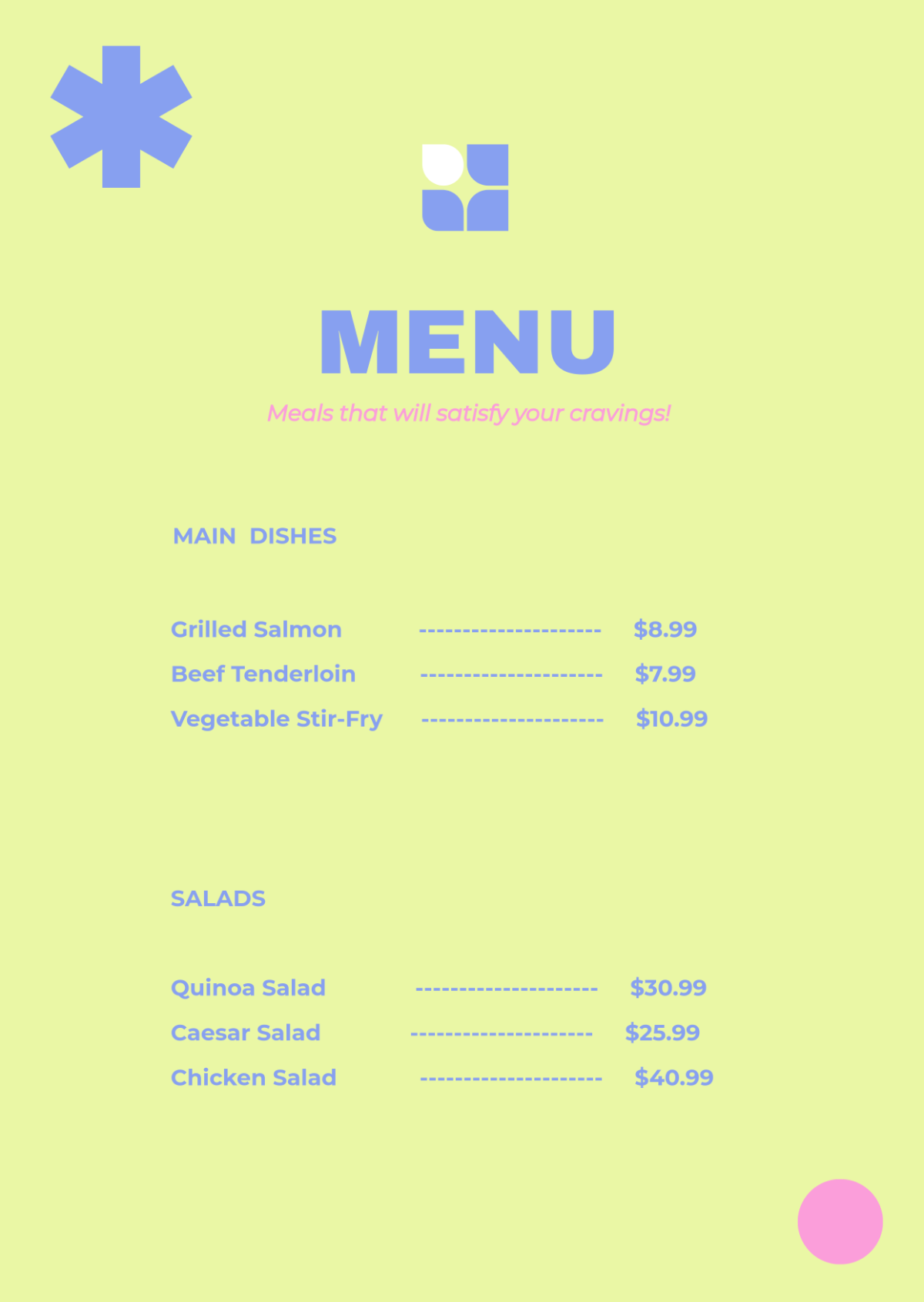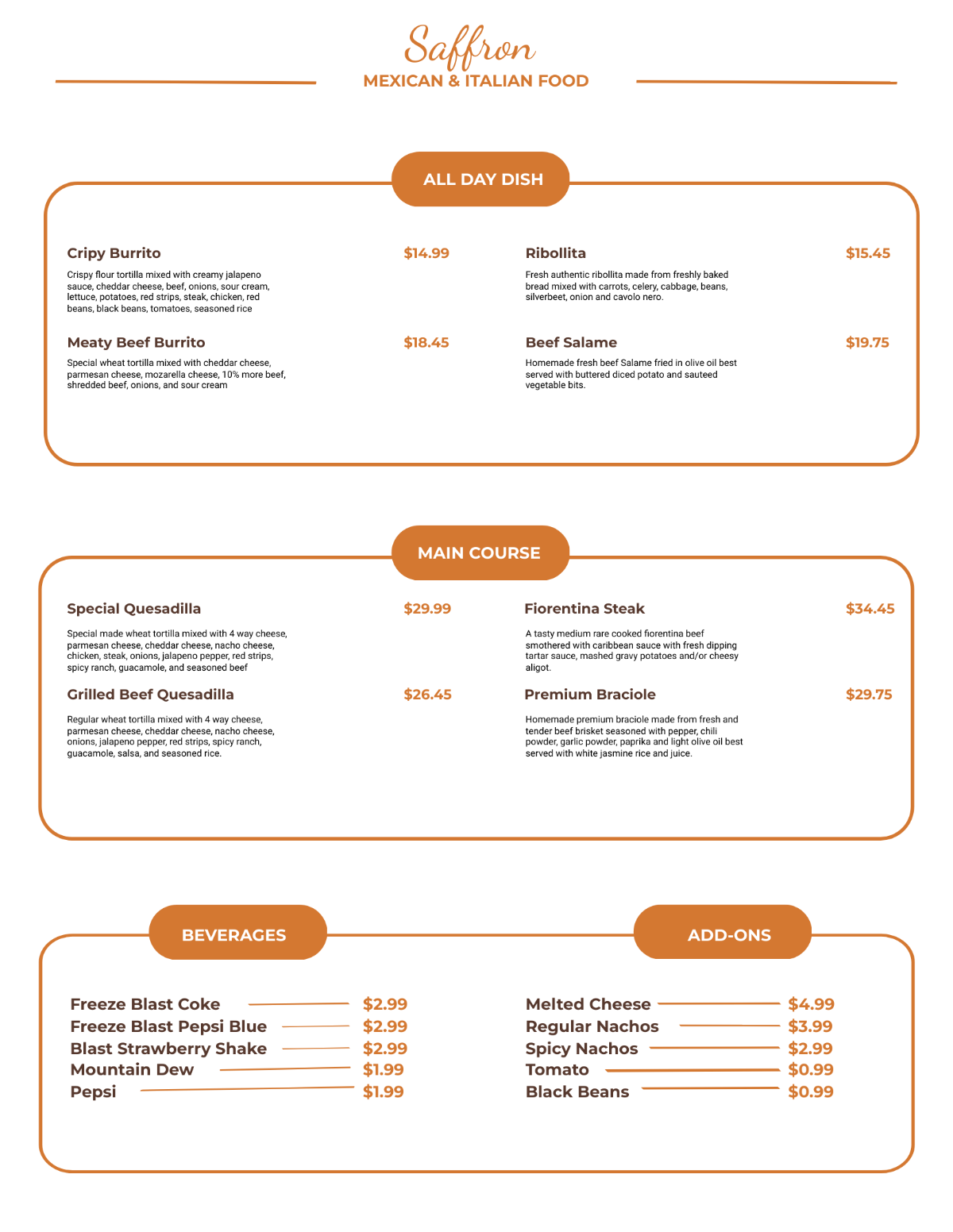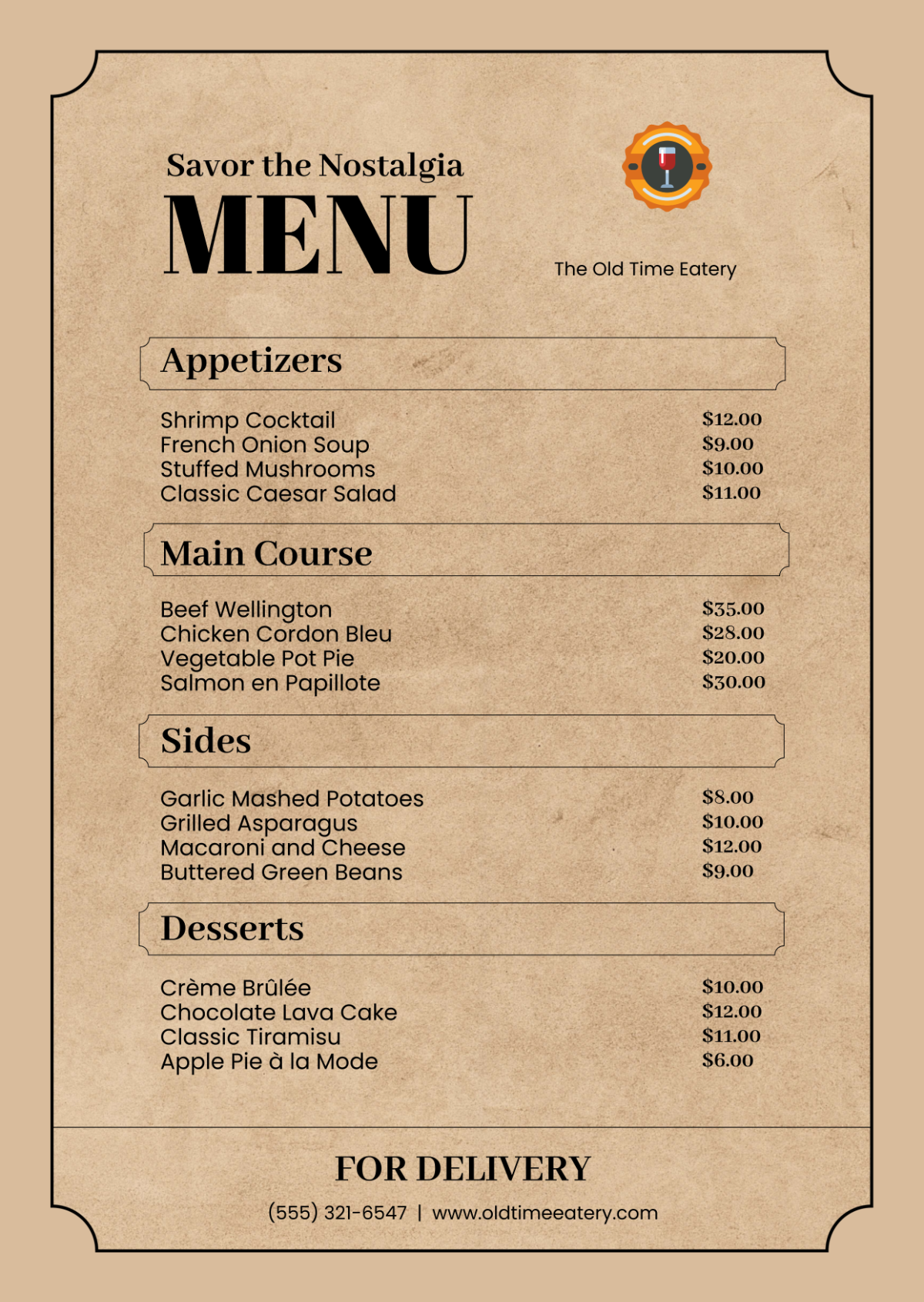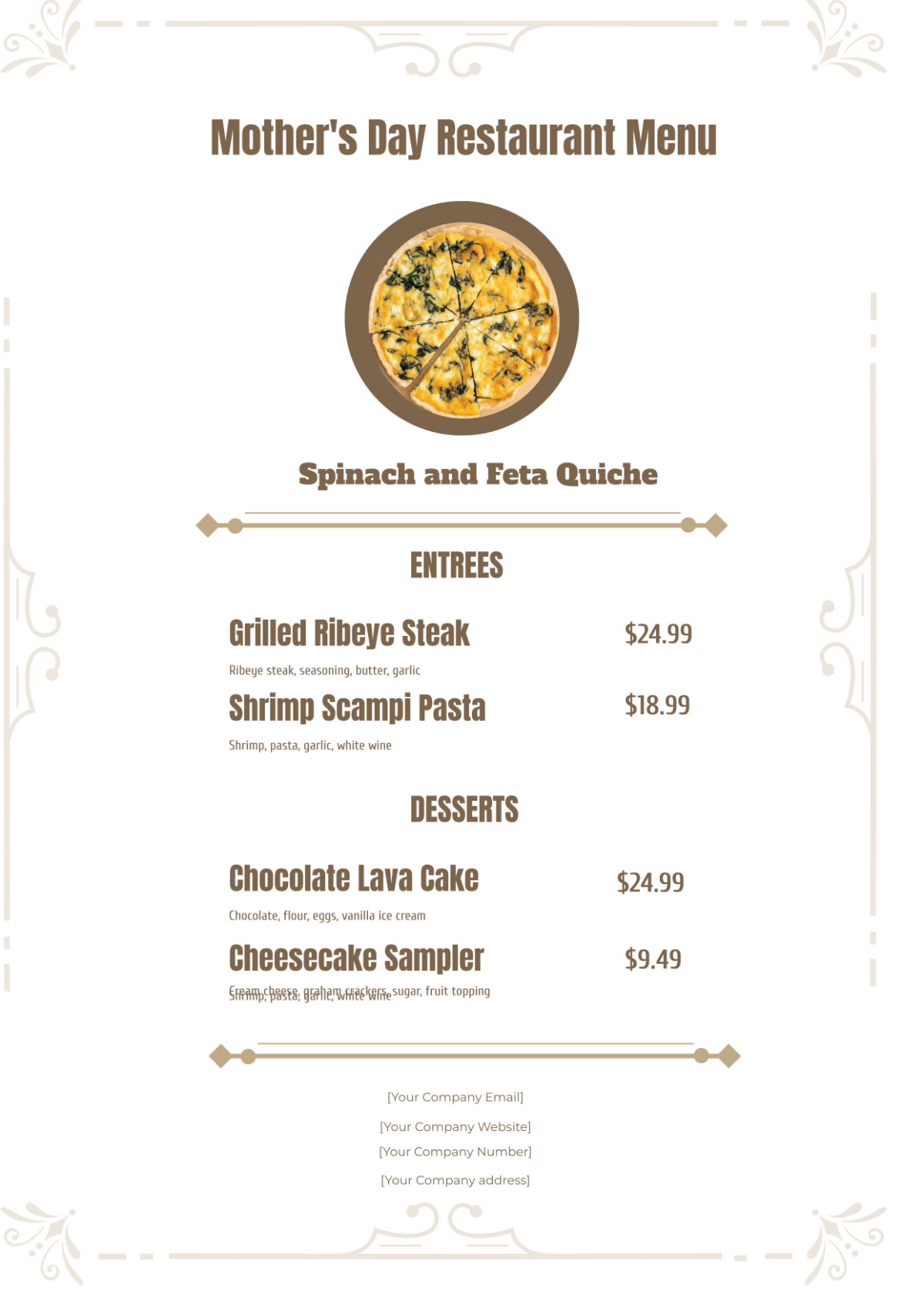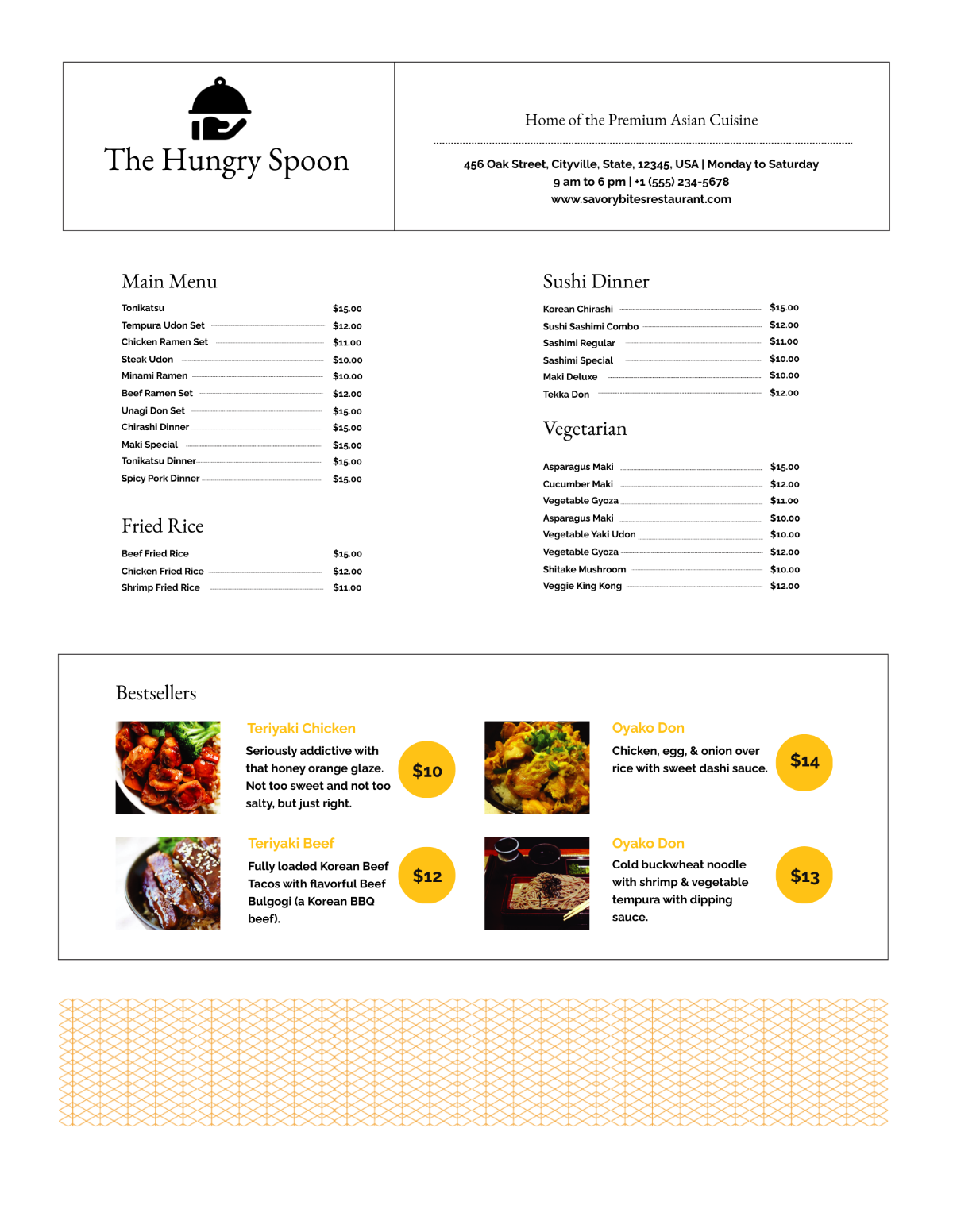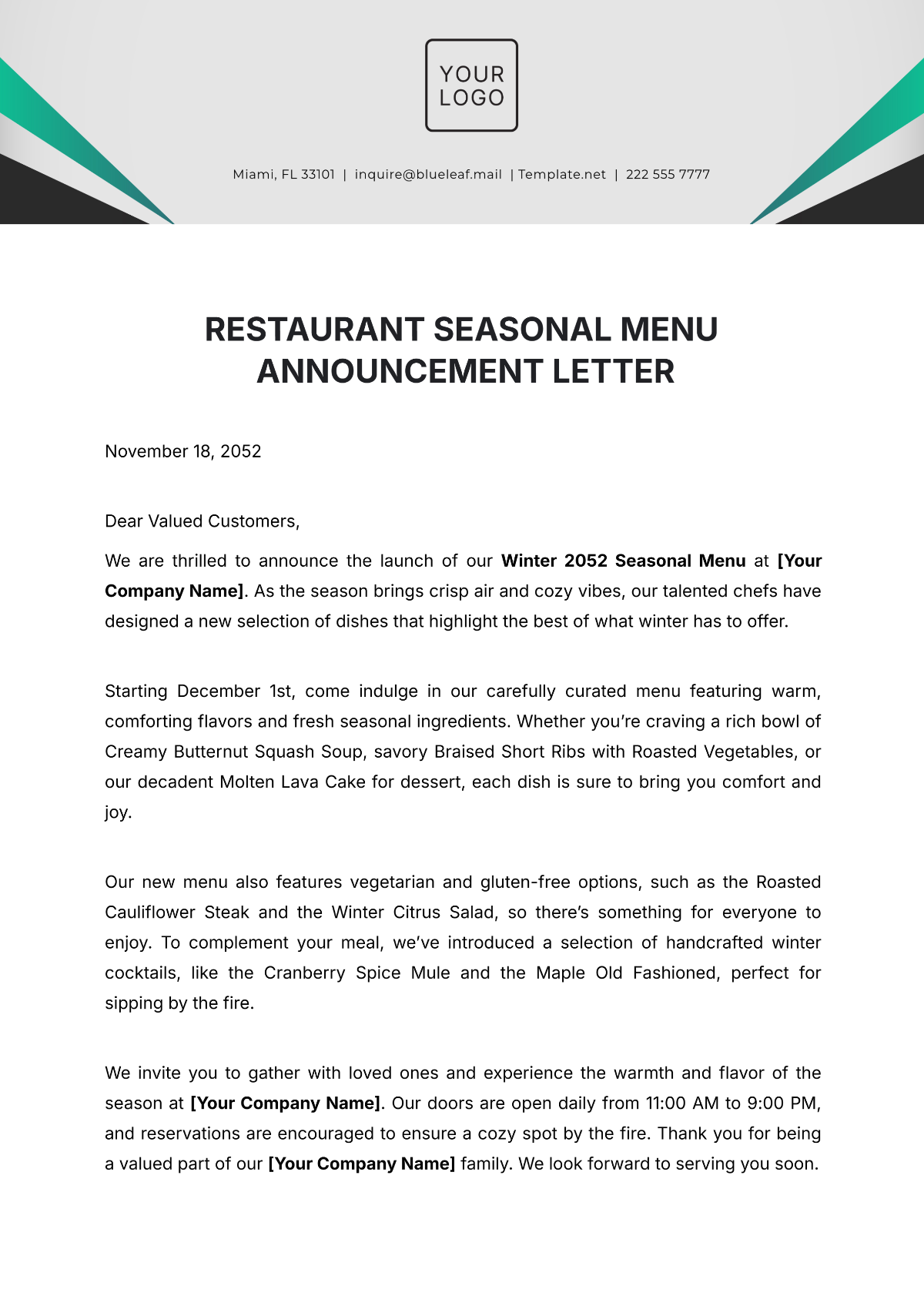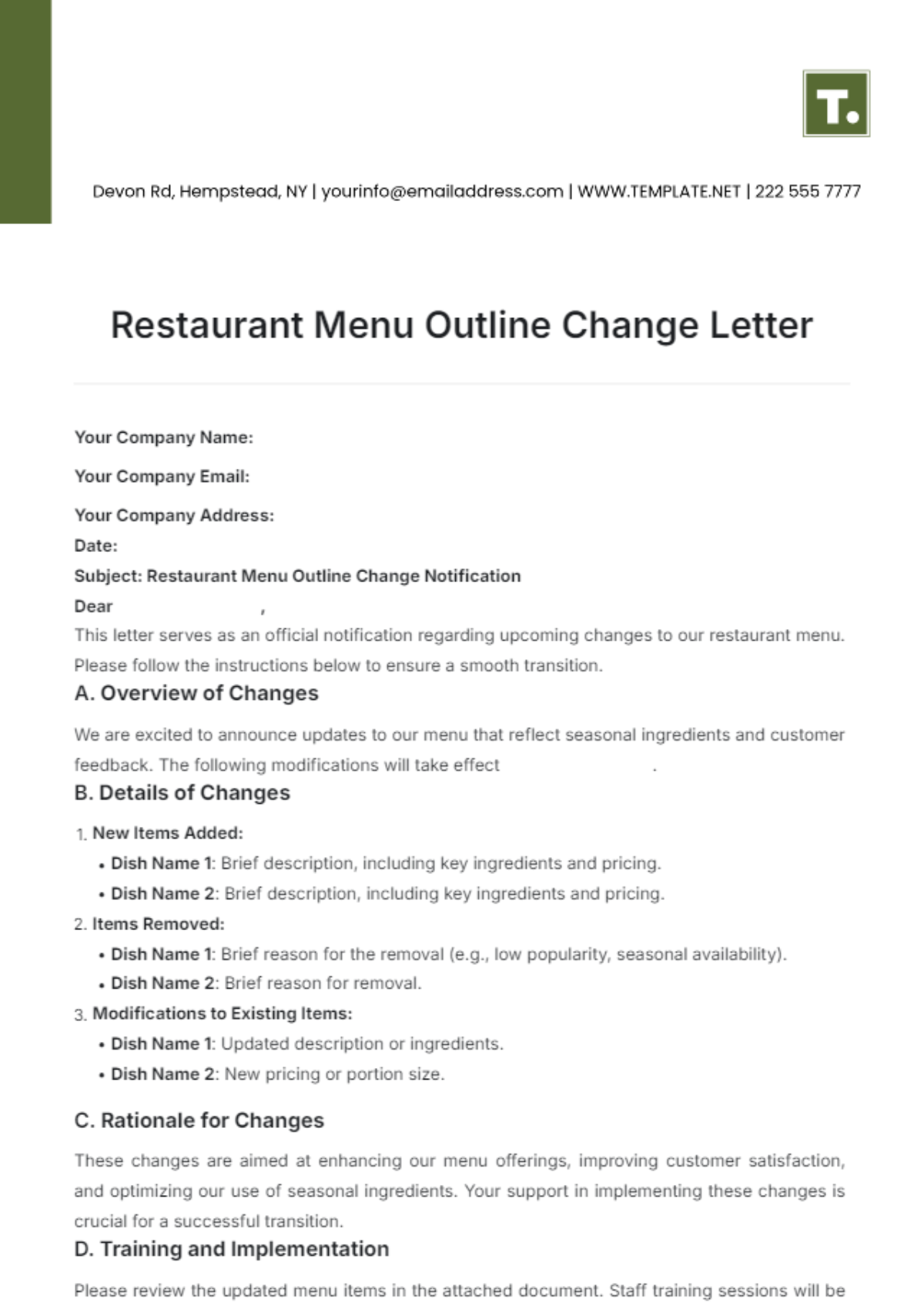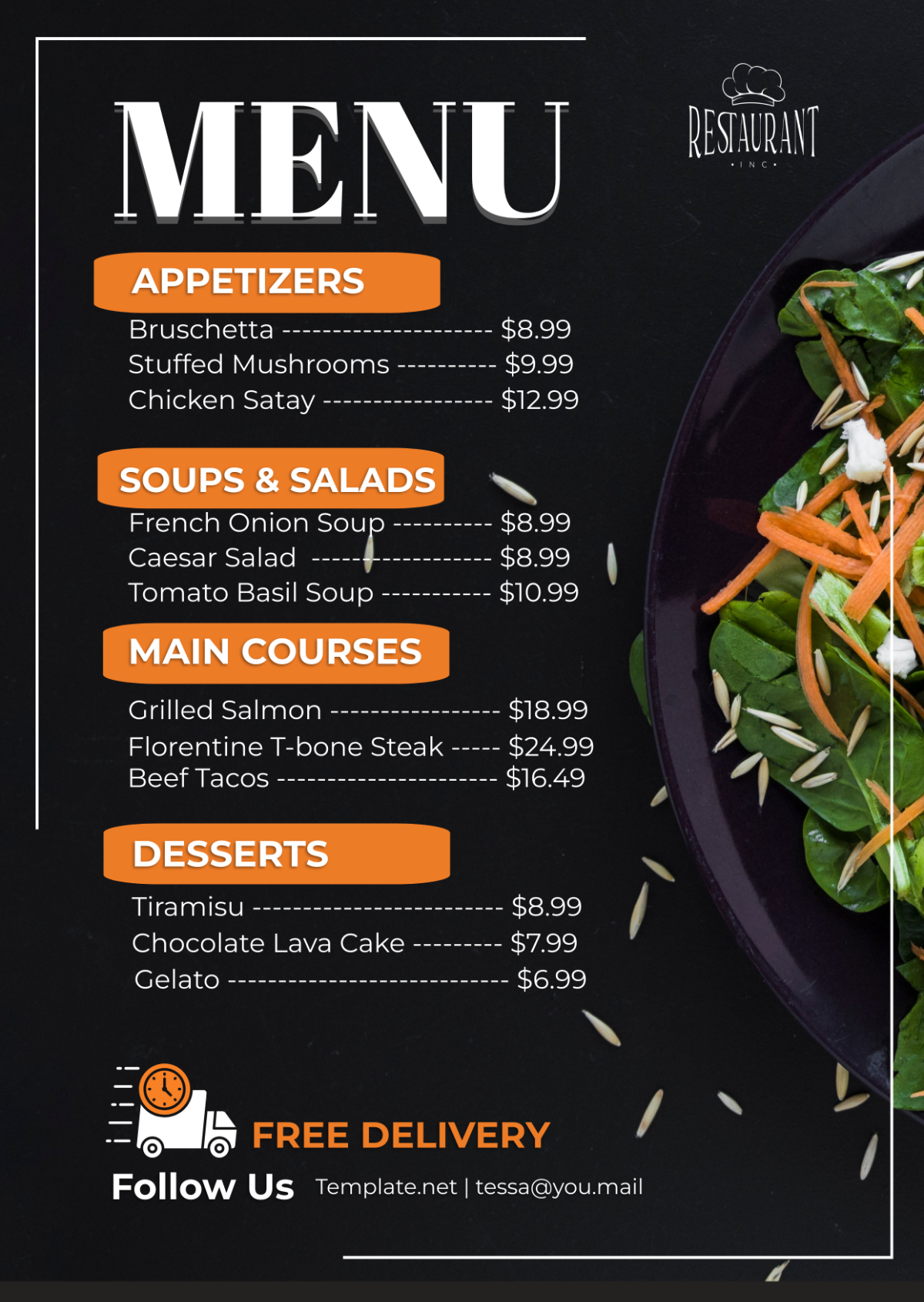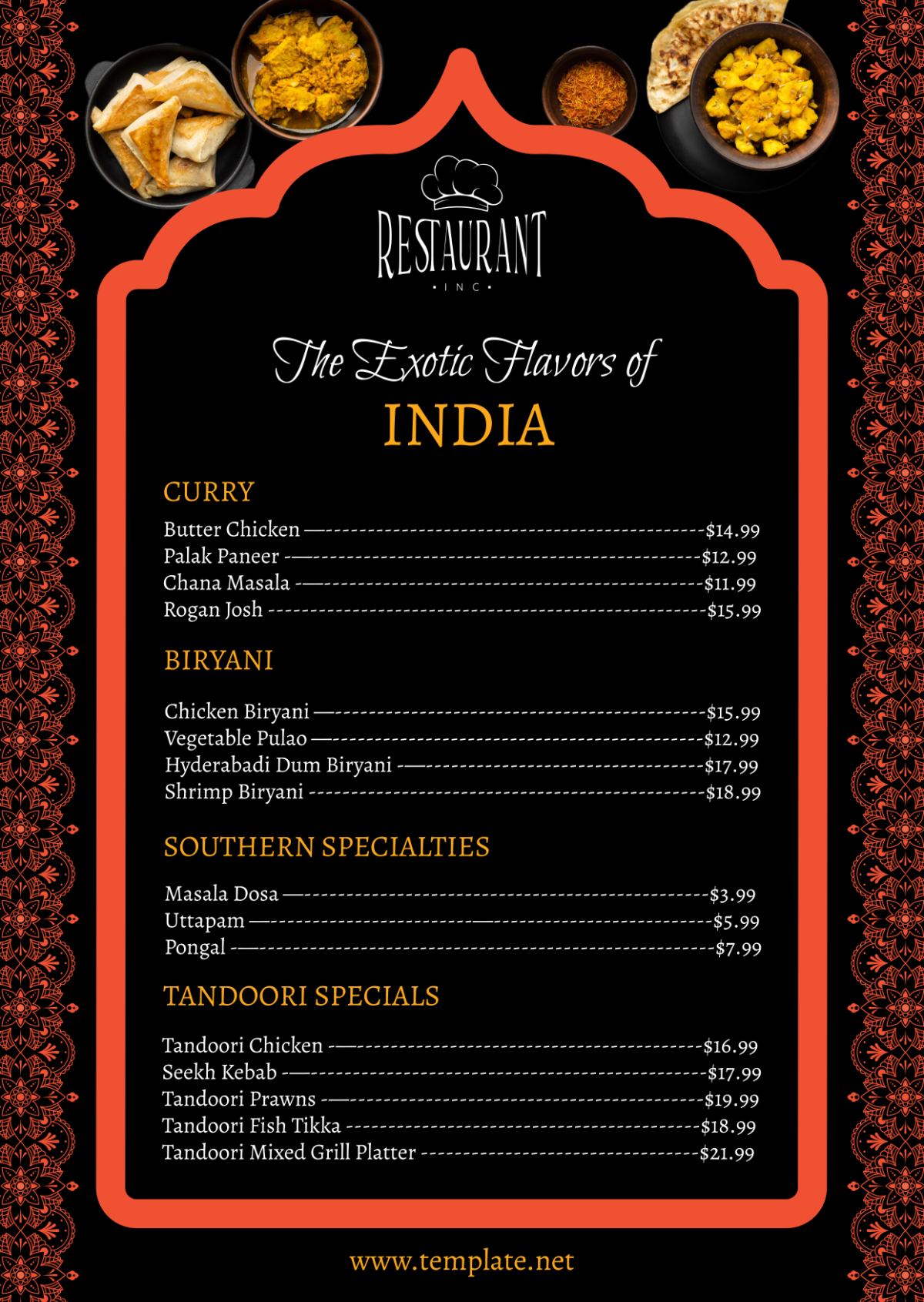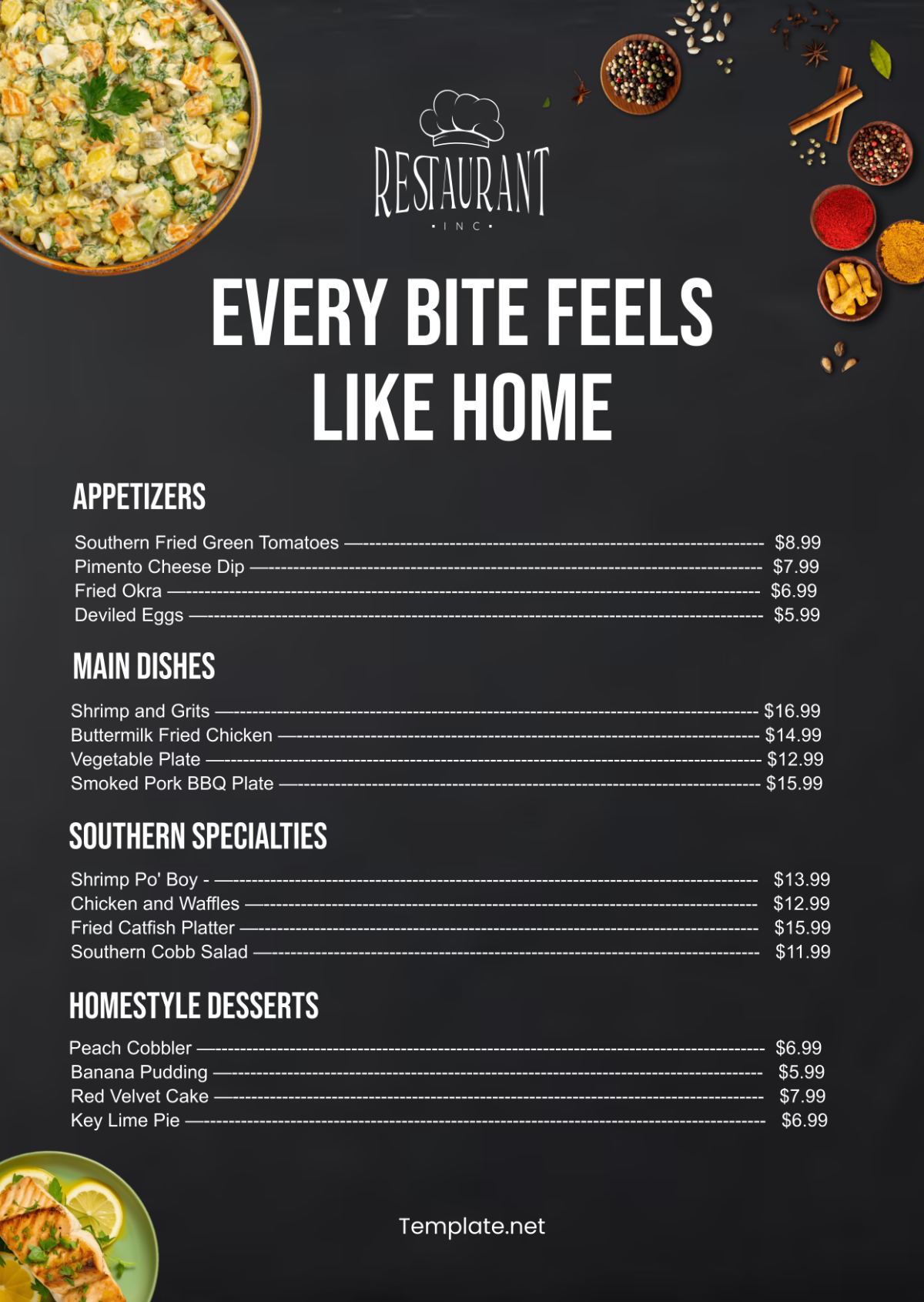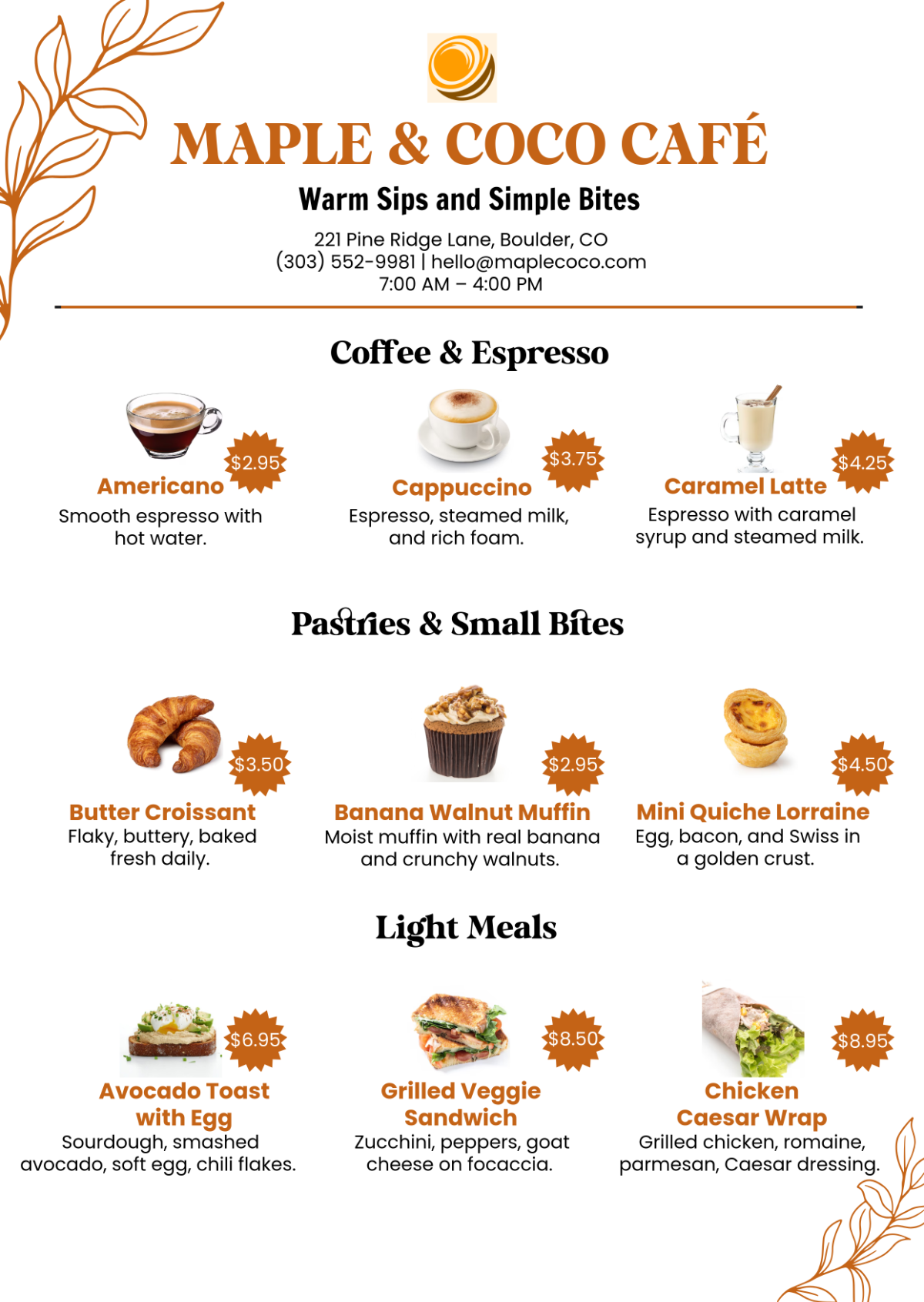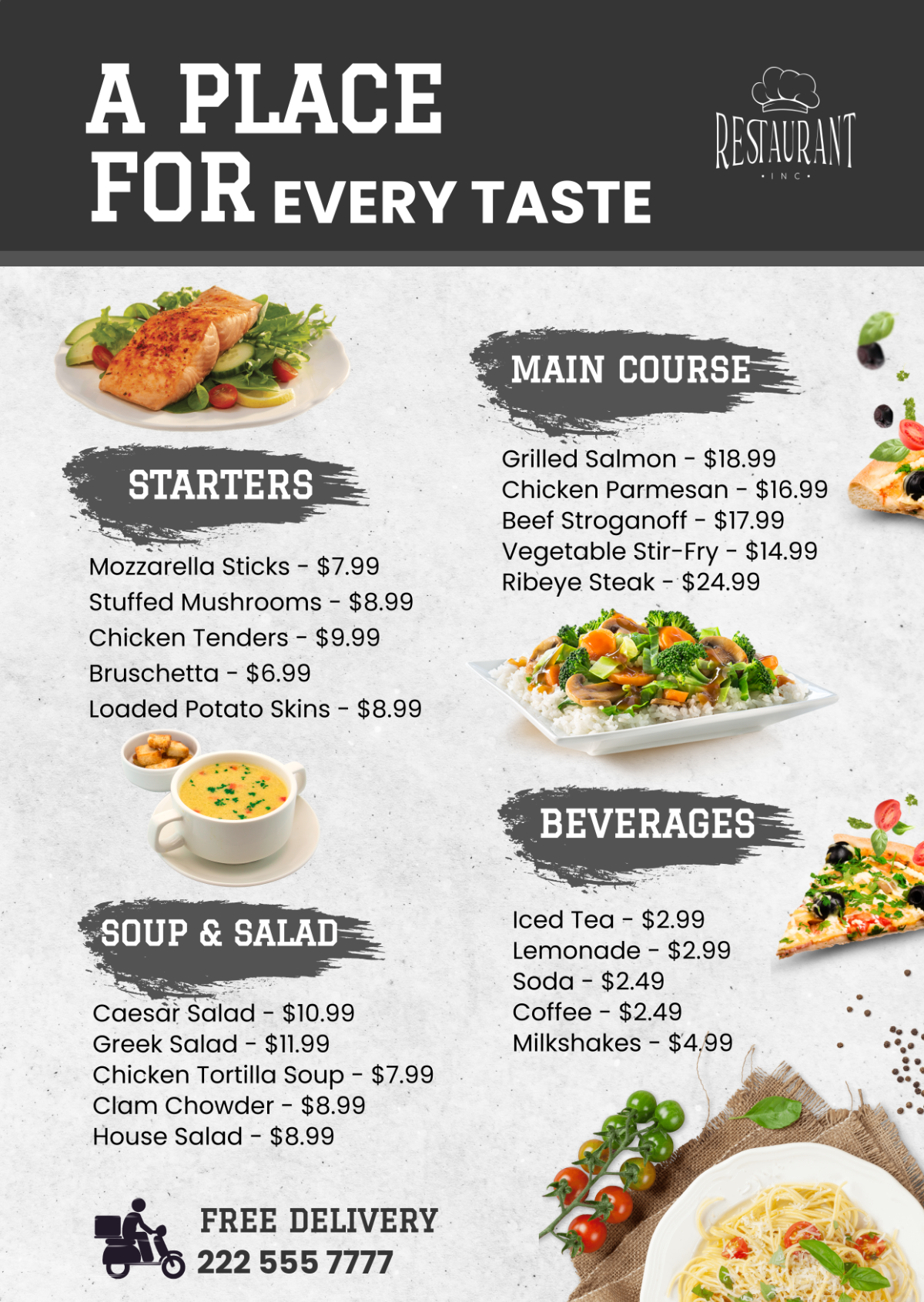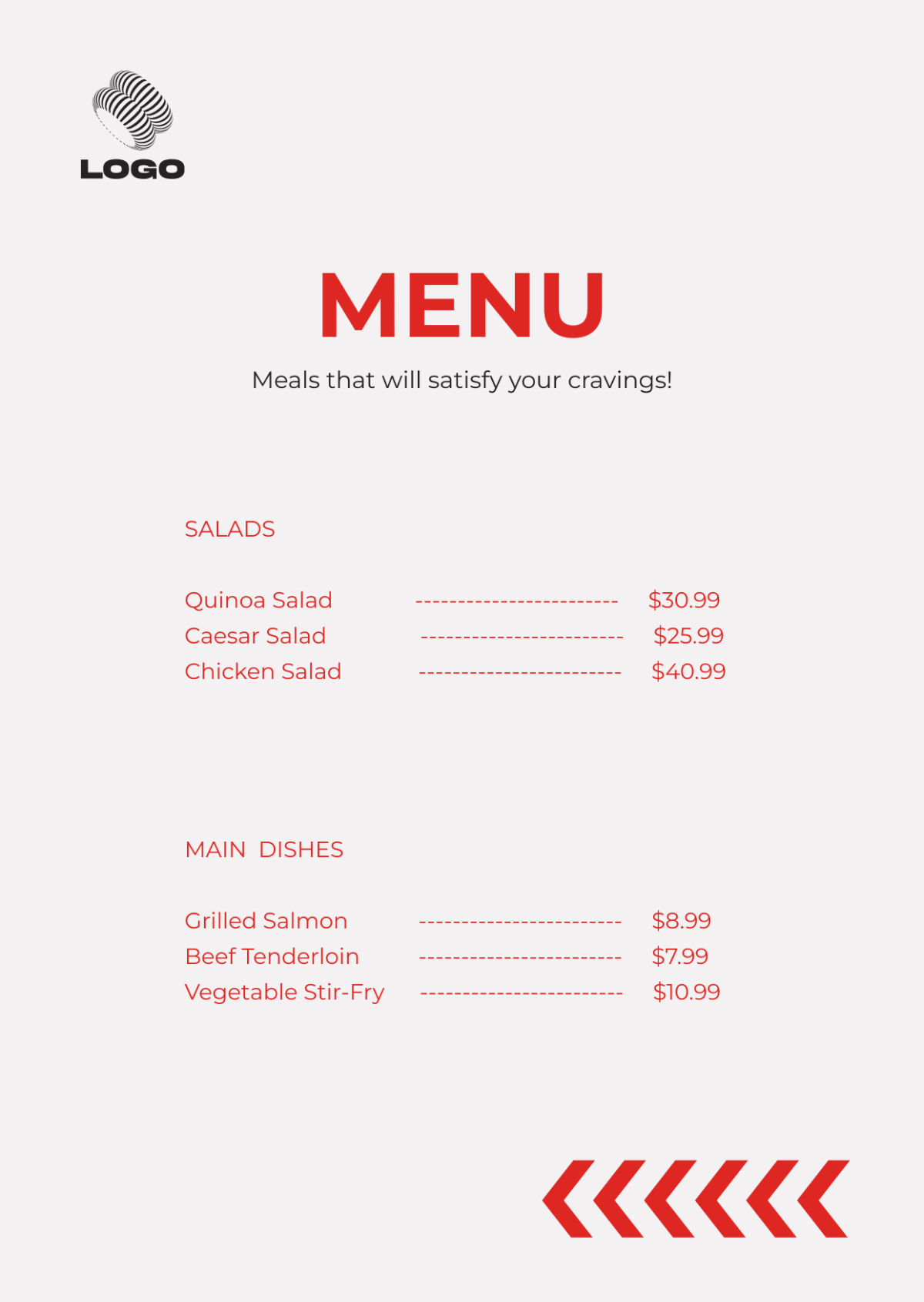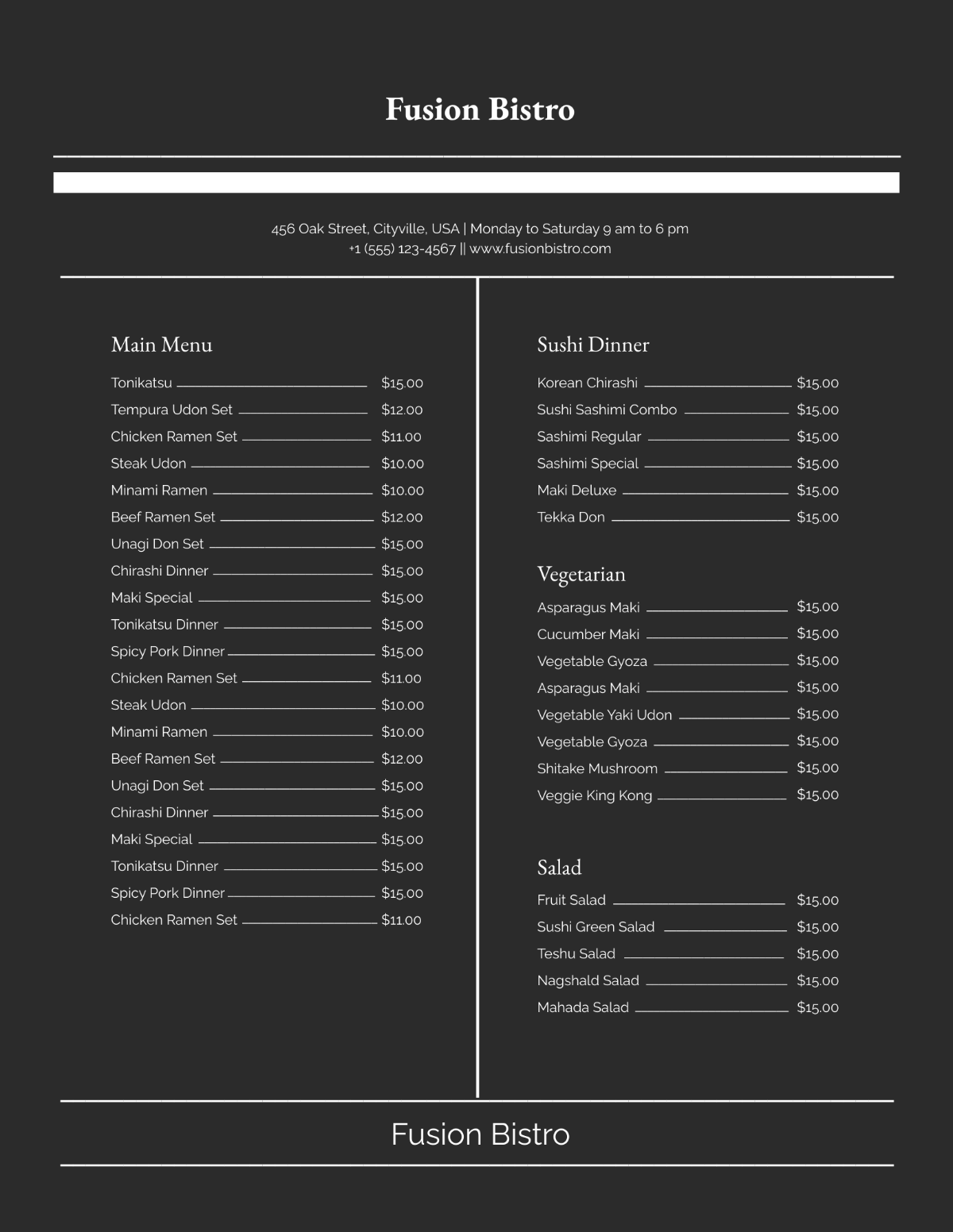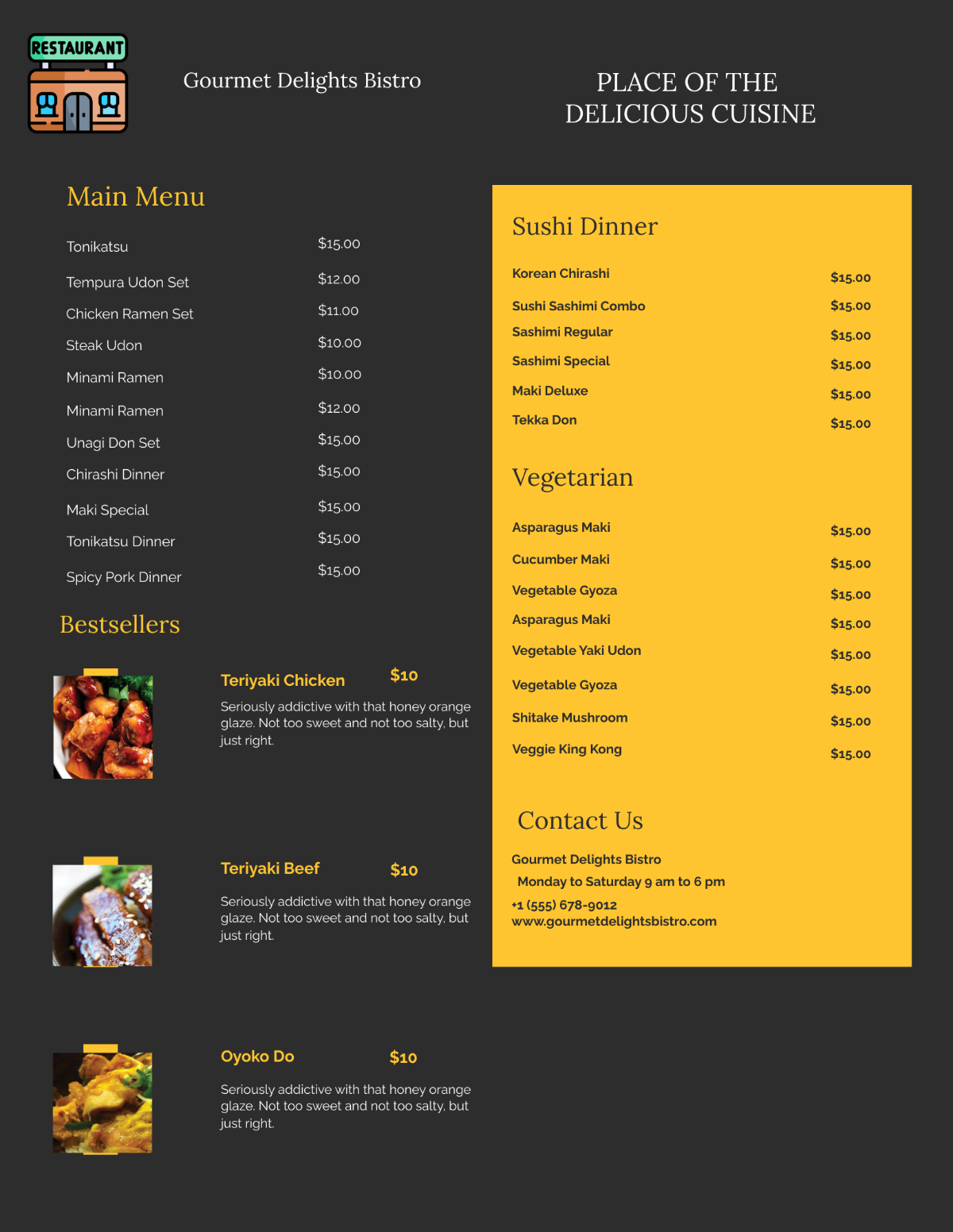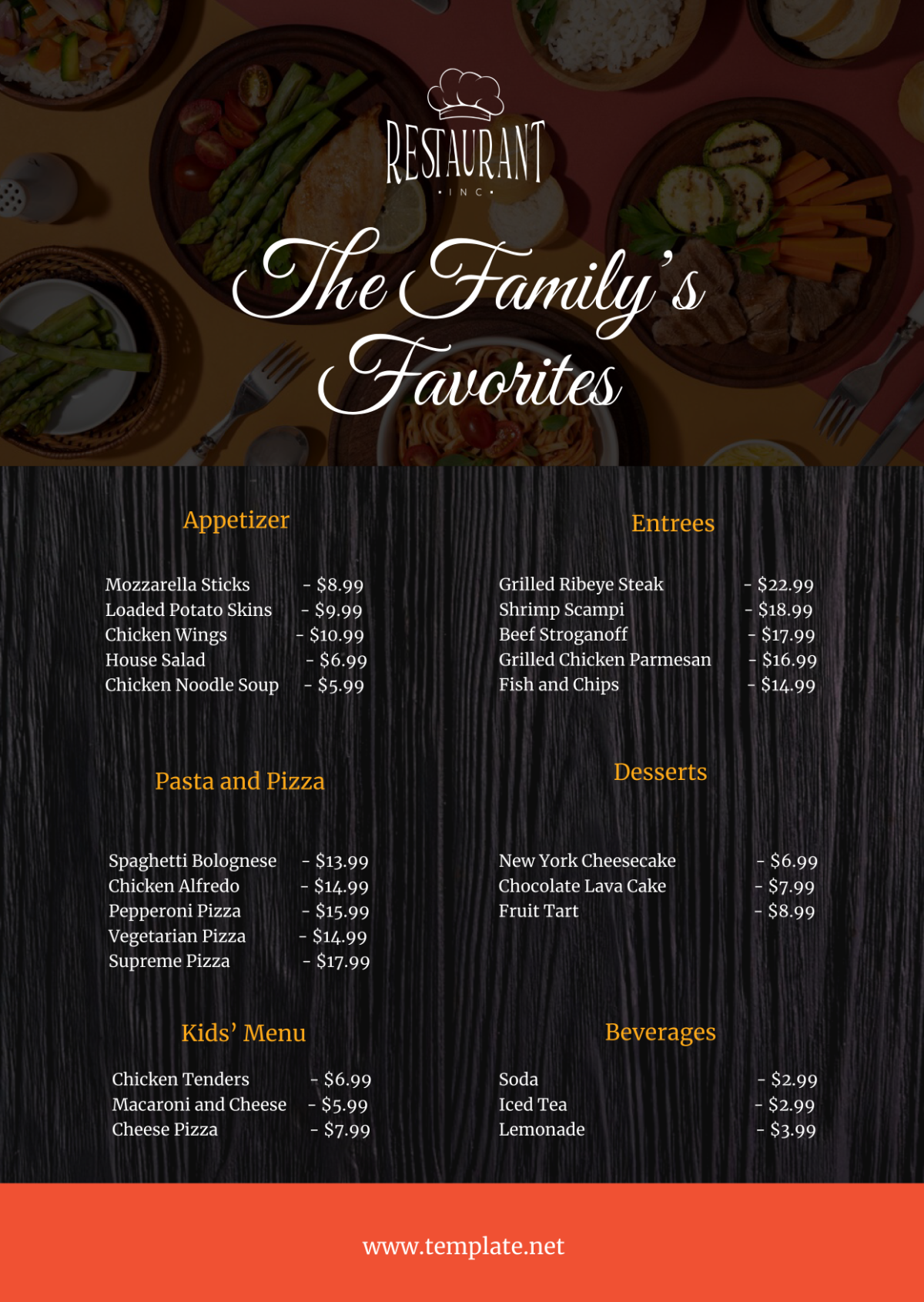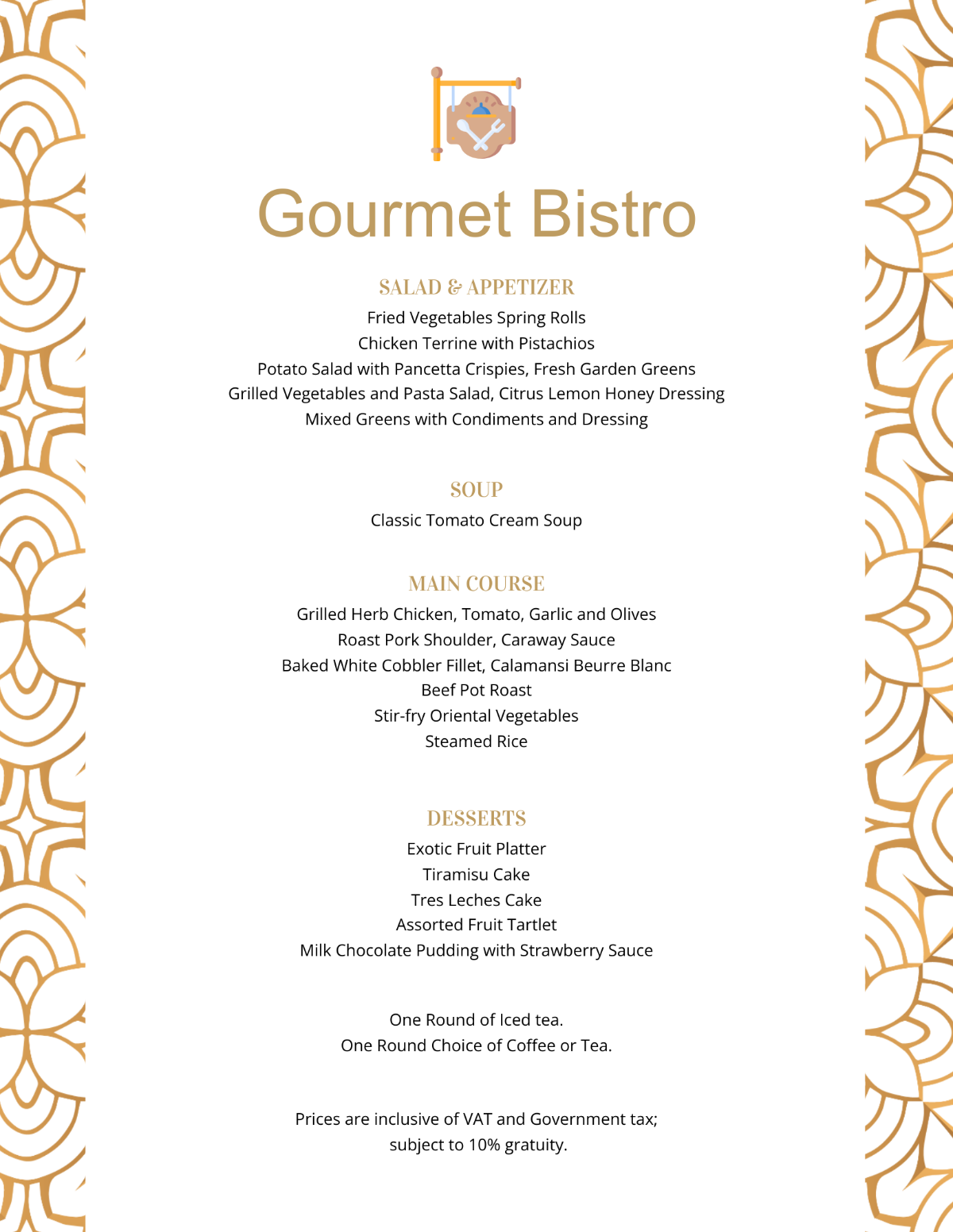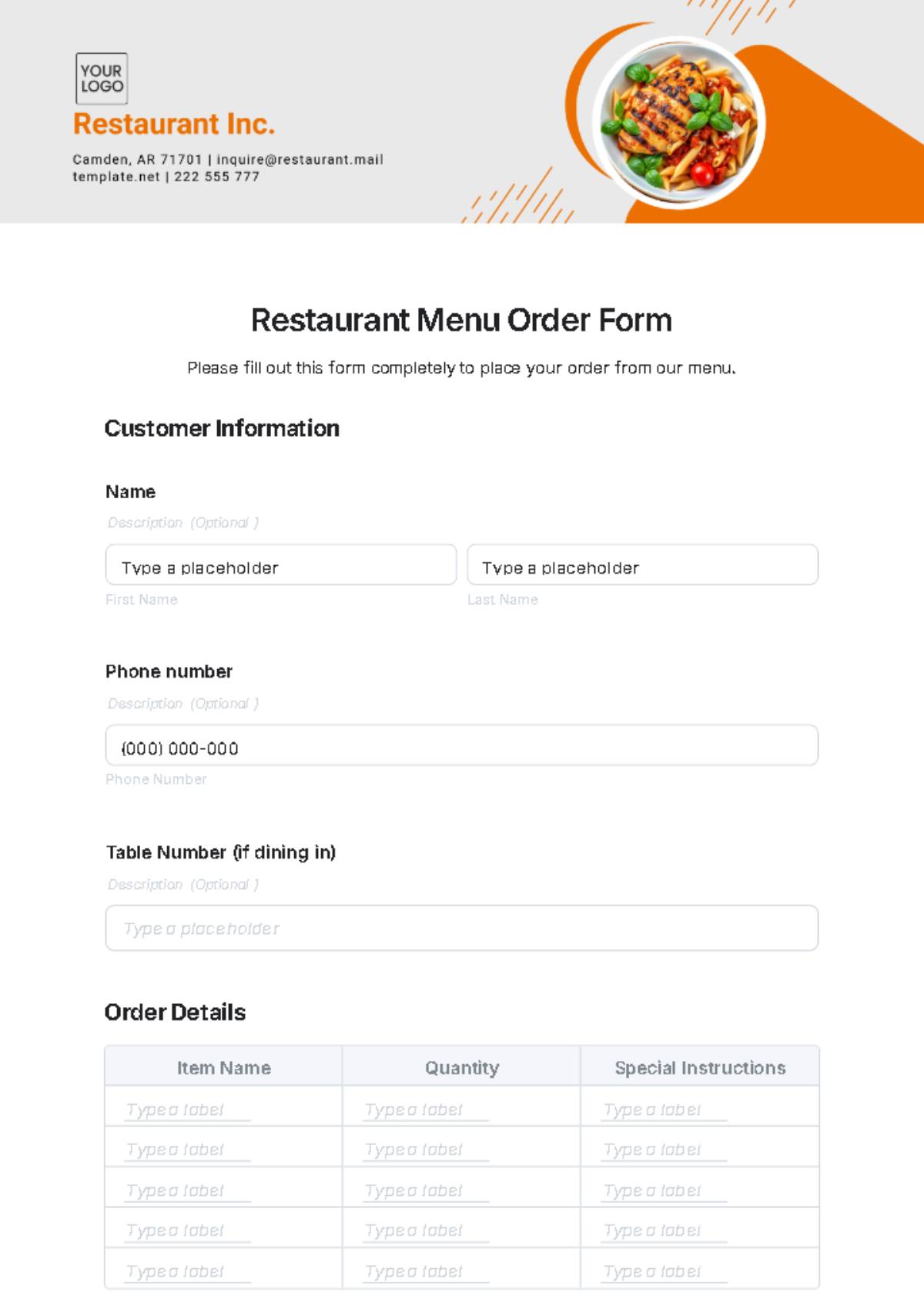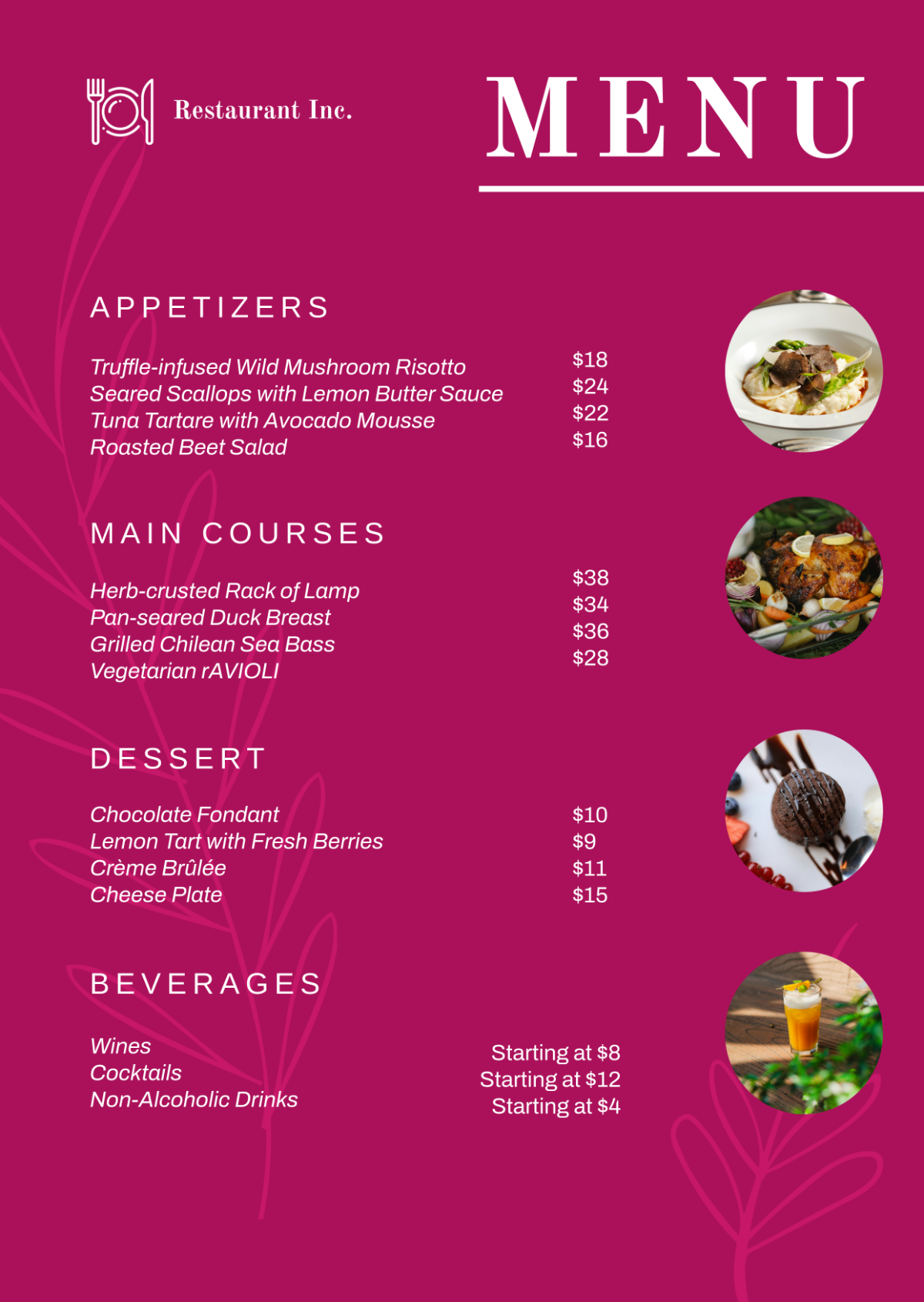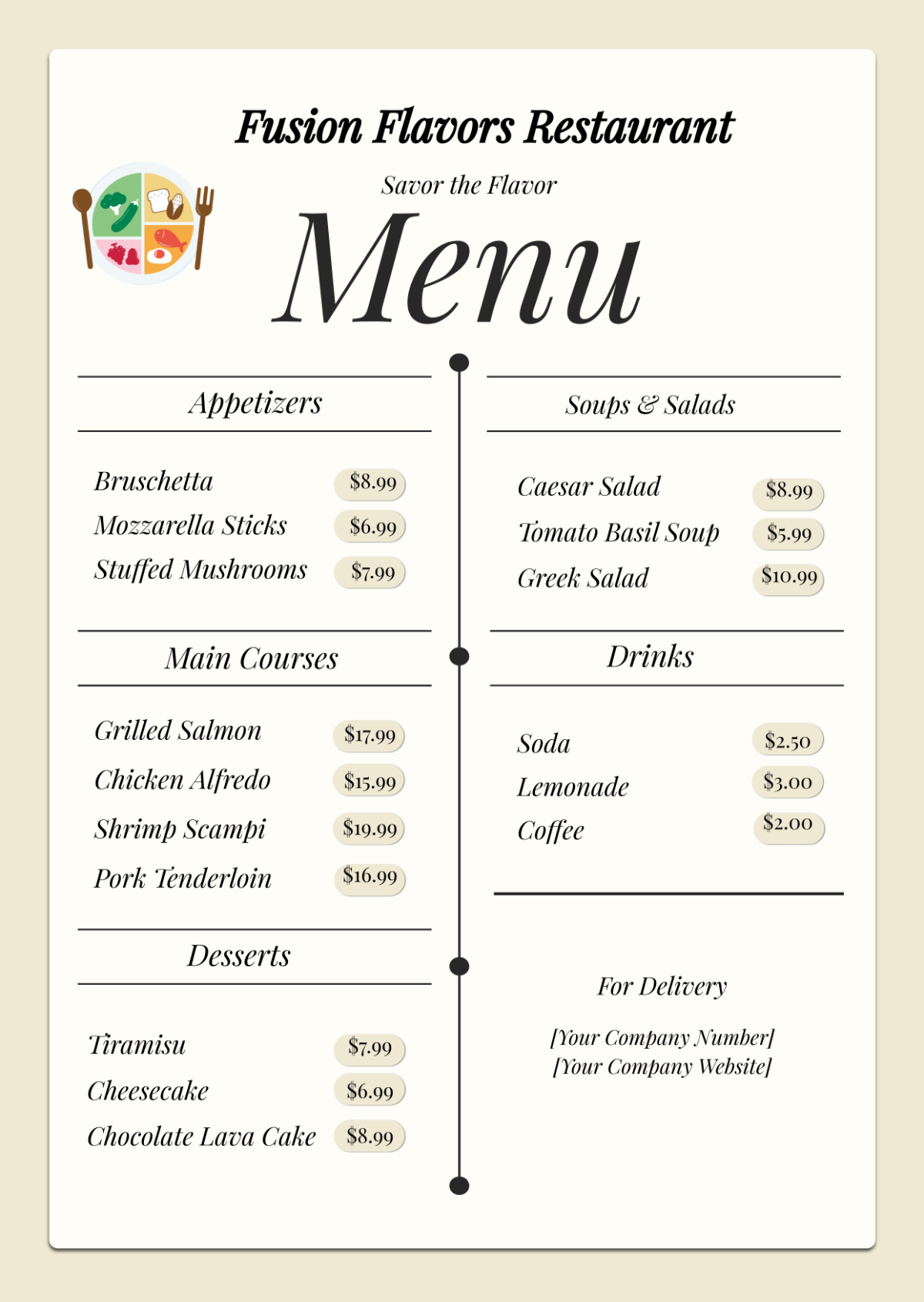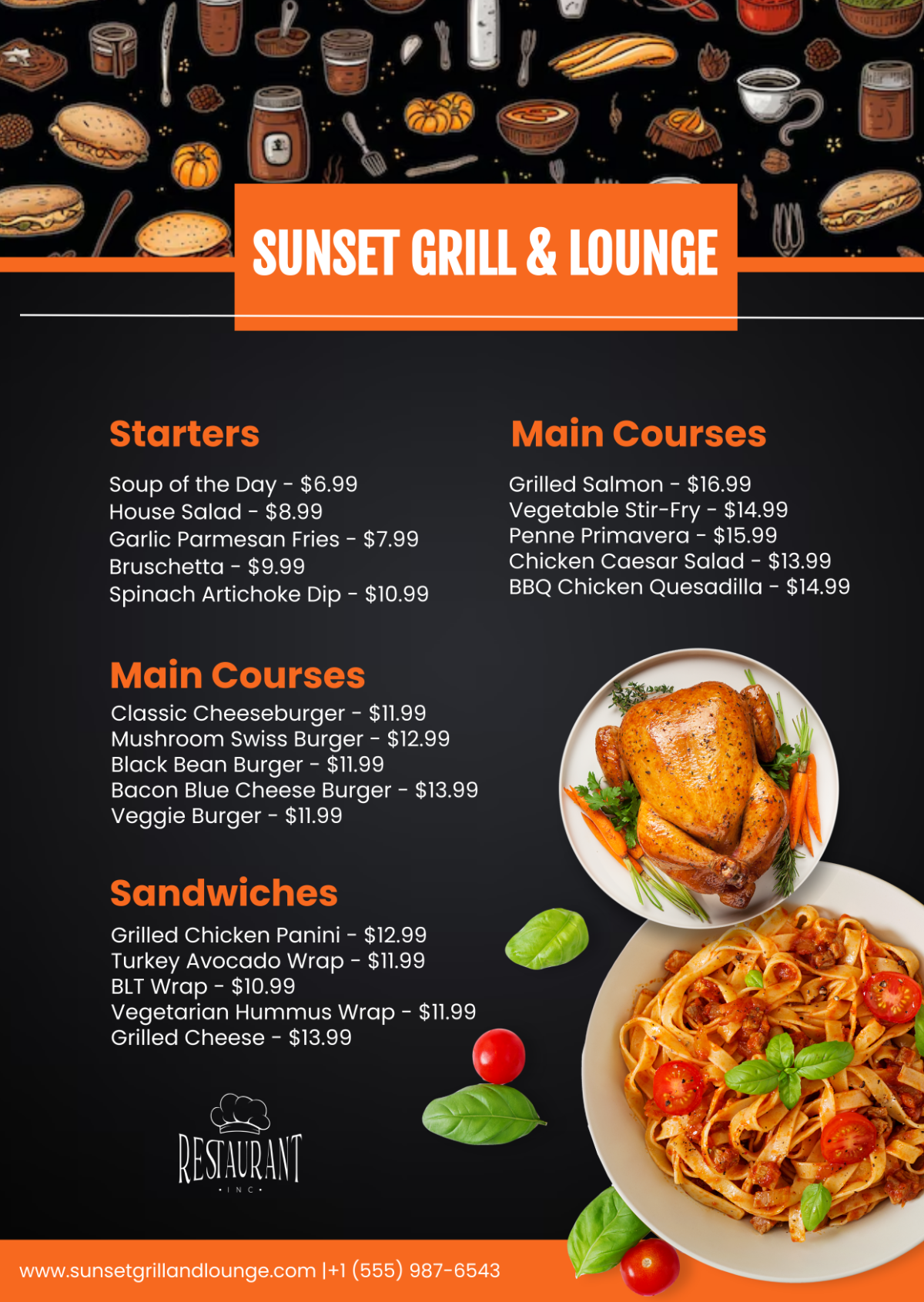Restaurant Menu Analysis Report
I. Executive Summary
This Restaurant Menu Analysis Report aims to evaluate the performance of our current menu, identify customer preferences, and recommend strategies for optimization. By analyzing sales data, customer feedback, and market trends, we aim to enhance the profitability and appeal of our menu offerings. This comprehensive analysis will guide our decisions on menu adjustments, new item introductions, and overall menu design.
Best-Selling Items: Our top three best-selling items are the Grilled Salmon, Margherita Pizza, and Caesar Salad.
Least-Selling Items: The items with the lowest sales are the Quinoa Salad, Tofu Stir-fry, and Beetroot Soup.
High Profitability: Dishes with the highest gross profit margins include the Ribeye Steak and Seafood Platter.
Customer Favorites: The Chocolate Lava Cake and Spaghetti Carbonara received the highest customer satisfaction ratings.
Areas for Improvement: Customers have requested more vegetarian and gluten-free options, and some items were noted for inconsistent quality.
Market Trends: There is a growing demand for plant-based dishes and sustainable seafood options.
II. Introduction
The purpose of this report is to provide a detailed analysis of our restaurant's menu performance. The scope of this report includes an examination of sales data, customer feedback, and market trends over the past six months. Our methodology involved collecting and analyzing quantitative data from our point-of-sale system and qualitative data from customer surveys and online reviews. This analysis will help us understand which items are performing well, which need improvement, and how we can better align our menu with current market trends and customer preferences.
III. Menu Performance Analysis
A. Sales Performance
Understanding the sales performance of each menu item is crucial for optimizing our offerings. The table below provides an overview of the sales metrics for our top and bottom-performing items over the past six months.
Menu Item | Units Sold | Total Revenue |
|---|---|---|
Grilled Salmon | 1,200 | $18,000 |
Margherita Pizza | 1,100 | $13,200 |
Caesar Salad | 950 | $9,500 |
Quinoa Salad | 200 | $2,000 |
Tofu Stir-fry | 180 | $1,800 |
Beetroot Soup | 150 | $1,500 |
Our best-selling items, such as the Grilled Salmon and Margherita Pizza, contribute significantly to our total revenue. Conversely, items like the Quinoa Salad and Beetroot Soup have low sales, indicating a potential need for menu revision or enhanced marketing efforts for these dishes.
B. Profitability
Analyzing the profitability of menu items helps us understand which dishes contribute the most to our bottom line. The table below outlines the gross profit margins for select items.
Menu Item | Cost per Item | Selling Price | Gross Profit Margin |
|---|---|---|---|
Ribeye Steak | $10 | $30 | 66.7% |
Seafood Platter | $15 | $45 | 66.7% |
Grilled Salmon | $8 | $15 | 46.7% |
Quinoa Salad | $5 | $10 | 50% |
Tofu Stir-fry | $4 | $10 | 60% |
High-margin items like the Ribeye Steak and Seafood Platter significantly boost our profitability. While the Grilled Salmon remains a popular choice, its lower margin suggests a need to balance popularity with profitability.
C. Popularity Index
The popularity index measures the frequency of orders and helps identify customer favorites. The table below provides the popularity metrics for our menu items.
Menu Item | Orders per Month | Popularity Rank |
|---|---|---|
Grilled Salmon | 200 | 1 |
Margherita Pizza | 183 | 2 |
Caesar Salad | 158 | 3 |
Chocolate Lava Cake | 145 | 4 |
Spaghetti Carbonara | 130 | 5 |
Beetroot Soup | 25 | 10 |
The Grilled Salmon and Margherita Pizza are the most popular items, consistently ranking high in orders per month. The Chocolate Lava Cake and Spaghetti Carbonara also show strong popularity, indicating high customer satisfaction with these dishes.
IV. Customer Feedback
A. Customer Satisfaction Ratings
Customer satisfaction is a key indicator of menu success. Over the past six months, we collected customer satisfaction ratings through surveys and online reviews. Overall, 82% of customers rated their dining experience as satisfactory or excellent.
B. Common Feedback
Customer feedback provides insights into both positive aspects and areas for improvement. The table below summarizes common feedback themes and their respective percentages.
Feedback Theme | Percentage |
|---|---|
Excellent Service | 45% |
Delicious Food | 40% |
Long Wait Times | 30% |
Inconsistent Quality | 20% |
Ambiance and Environment | 25% |
Need for More Vegetarian Options | 15% |
Positive feedback highlights our excellent service and delicious food, with 45% and 40% of comments respectively. However, long wait times (30%) and inconsistent quality (20%) are areas that need attention. There is also a notable demand for more vegetarian options (15%).
C. Special Dietary Requests
Understanding the frequency and nature of special dietary requests can help us cater to a broader customer base. The table below shows the frequency of common dietary requests.
Special Dietary Request | Frequency per Month |
|---|---|
Vegetarian | 50 |
Vegan | 30 |
Gluten-Free | 20 |
Nut-Free | 10 |
Dairy-Free | 15 |
Customer suggestions often include requests for more diverse vegetarian and vegan options. Additionally, there is a steady demand for gluten-free and dairy-free dishes. Addressing these requests can enhance customer satisfaction and attract a wider audience.
V. Market Trends
A. Industry Trends
Understanding current industry trends is crucial for keeping our menu relevant and appealing to customers. The restaurant industry has seen a significant shift towards health-conscious and sustainable dining. Plant-based and sustainable seafood options are on the rise, with a 20% increase in demand for vegetarian and vegan dishes over the past year. Additionally, there is a growing interest in globally inspired cuisines, such as Mediterranean and Southeast Asian.
Cuisine Preference | Rising Demand (%) |
|---|---|
Plant-Based/Vegan | 20% |
Sustainable Seafood | 15% |
Mediterranean | 10% |
Southeast Asian | 12% |
Gluten-Free Options | 8% |
These trends indicate a shift towards healthier and more environmentally conscious dining choices, suggesting that incorporating such options into our menu could attract more customers.
B. Competitive Analysis
A competitive analysis helps us understand how we stand against other restaurants in the market. The table below provides an overview of our main competitors, their market share, and their most popular menu items.
Competitor | Market Share (%) | Popular Menu Items |
|---|---|---|
Competitor A | 25% | Grilled Chicken, Vegan Burger |
Competitor B | 20% | Sushi Platter, Quinoa Salad |
Competitor C | 15% | Pizza Margherita, Gluten-Free Pasta |
Competitor A, with a 25% market share, is popular for its Grilled Chicken and Vegan Burger, indicating a successful balance of traditional and plant-based options. Competitor B’s success with Sushi Platters and Quinoa Salads highlights the growing popularity of healthy and globally inspired dishes. Competitor C’s focus on Italian cuisine, especially with gluten-free options, also shows a niche yet significant market demand.
VI. Menu Engineering
Menu engineering involves analyzing the profitability and popularity of menu items to optimize the menu for maximum revenue and customer satisfaction. The table below categorizes our menu items into four quadrants based on their profitability and popularity.
Menu Item | Profitability | Popularity |
|---|---|---|
Grilled Salmon | High | High |
Margherita Pizza | Medium | High |
Caesar Salad | Medium | Medium |
Ribeye Steak | High | Medium |
Chocolate Lava Cake | Medium | High |
Tofu Stir-fry | Low | Low |
Quinoa Salad | Low | Low |
Beetroot Soup | Low | Low |
Stars (High Profitability, High Popularity): Grilled Salmon
Plowhorses (Low Profitability, High Popularity): Margherita Pizza
Puzzles (High Profitability, Low Popularity): Ribeye Steak
Dogs (Low Profitability, Low Popularity): Tofu Stir-fry, Quinoa Salad
Analyzing this matrix, we can see that the Grilled Salmon is a star performer, both popular and highly profitable. The Margherita Pizza and Chocolate Lava Cake, although popular, have lower profitability and might benefit from slight price adjustments or cost optimization. The Ribeye Steak, being profitable but less popular, could be promoted more or paired with side items to enhance its appeal. Conversely, items like the Tofu Stir-fry, Quinoa Salad, and Beetroot Soup, which are neither popular nor profitable, should be reconsidered for revision or removal.
VII. Areas of Improvement
Based on our analysis of the menu performance, customer feedback, and market trends, we have identified several key areas for improvement. Addressing these areas will help us enhance customer satisfaction, optimize menu offerings, and increase overall profitability.
Reduce Wait Times: Improve kitchen efficiency and streamline order processing during peak hours.
Enhance Special Requests Handling: Better accommodate dietary preferences and special requests.
Increase Vegetarian and Gluten-Free Options: Expand menu offerings to include more plant-based and gluten-free dishes.
Promote High-Margin Items: Develop marketing strategies to increase the popularity of high-margin items like the Ribeye Steak.
Improve Consistency: Ensure consistent quality across all menu items to maintain customer satisfaction.
Revise or Remove Low-Performing Items: Reevaluate the inclusion of low-performing items such as the Tofu Stir-fry, Quinoa Salad, and Beetroot Soup.
VIII. Action Plan
To address the identified areas of improvement, we have developed a detailed action plan. This plan includes specific steps, timelines, and assigned responsibilities to ensure effective implementation.
Step | Timeline |
|---|---|
Improve kitchen efficiency | 1 month |
Enhance training for special requests | 2 months |
Expand vegetarian and gluten-free options | 3 months |
Develop marketing strategies for high-margin items | 2 months |
Implement quality control measures | 1 month |
Revise or remove low-performing items | 1 month |
IX. Conclusion
This Restaurant Menu Analysis Report provides a comprehensive overview of our menu's performance, customer feedback, and market trends. By addressing the identified areas of improvement and implementing the proposed action plan, we can optimize our menu for better performance and customer satisfaction. Let’s work together to make these positive changes and continue delivering an exceptional dining experience to our guests.









